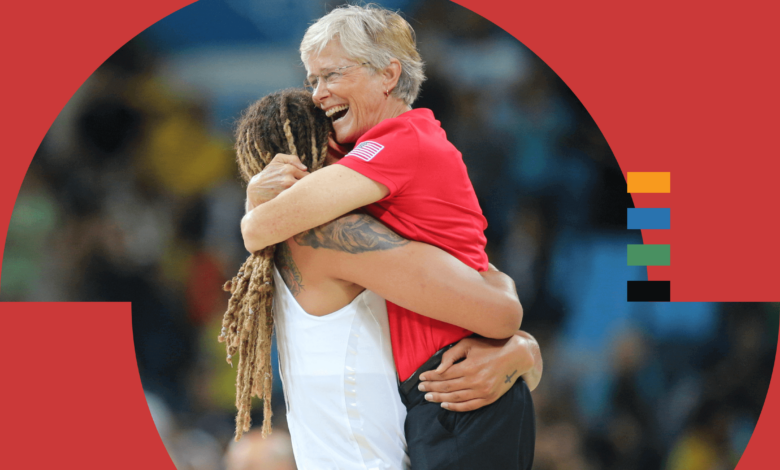Meet Carol Callan, the Behind-the-Scenes Architect of the American Women’s Basketball Dynasty

FFollow the live broadcast of the second day of the Paris 2024 Olympic Games, including special gymnastics broadcasts
LILLE, France — For the last seven Summer Olympics, Carol Callan has woken up the morning of the Opening Ceremony with a checklist and a hypothetical fire extinguisher. The checklist included everything that could possibly go wrong: missing laces, training schedules that needed to be adjusted, alternate transportation solutions, alternate uniforms packed in case Team USA’s opponents showed up in the wrong gear. Every metaphorical gap that might exist between that moment and a gold medal had been anticipated (and addressed in advance) by Callan, who served as director of USA Basketball’s women’s program from 1996 through the 2021 Tokyo Games.
But on Friday, the day of the Opening Ceremony, Callan woke up in Paris after an overnight flight from the United States. There was no checklist or fire extinguisher. No stowed shoelaces. No directory of emergency public transit phone numbers available in Paris. After helping Team USA win its seventh consecutive gold medal in Tokyo, she quit to work full-time for FIBA.
While her role is an adjacent one, continuing the growth of basketball globally and specifically for women in the game, things are very different now. And as the Games begin and Team USA seeks its eighth gold medal of the series — the first without Callan at the helm of the program — Callan admits she’s not sure what it’ll feel like to go through the Games without holding that hypothetical fire extinguisher.
Because from Atlanta to Athens, London to Tokyo, Callan was a true shape-shifter, meeting the needs of every team during their Olympic journey and the four years before that.
In 1996, she was then-head coach Tara VanDerveer’s running partner every other day during the year-long tour leading up to the Atlanta Games. In 2004, Callan started each morning with Van Chancellor over coffee, knowing that was how he began his days at home. And in the 2012 and 2016 cycles, she hit the golf course with Geno Auriemma, the only two-time coach on the Olympic team. In 2021, with the Olympics bereft of the usual pomp and circumstance, Callan knew Dawn Staley needed a reminder that — as with Staley as a player and an assistant — all she had to do was take care of the basketball side of things and Callan and her team would take care of the rest.
“She’s the common denominator behind all the success,” said current Olympic team coach Cheryl Reeve. “The culture she created, the attention to detail, the discipline she wanted the team to have, that was all Carol.”
“When you have success in an organization or a team, there’s always someone working behind the scenes,” Staley said. “Carol is that for us. The secret to our success is her.”
“She is the architect,” said Diana Taurasi, now competing in her sixth Olympic Games.

Geno Auriemma and Carol Callan in 2013. Callan was responsible for both of Auriemma’s stints as head coach of the U.S. women’s national team. (John Woike / Hartford Courant / MCT via Getty Images)
From the outset, Callan’s role extended far beyond the usual duties of a team director, as she understood that the purpose of this national program would go far beyond just winning.
Callan joined USA Basketball in 1989 as a high school representative on the Games Committee, the group charged with selecting coaches and players for USA Basketball’s women’s teams. She was a high school athletic director and assistant principal at the time, and posed little threat to the college coaches on the committee. In 1993, she was promoted to the role of secretary of the executive committee when the committee was split into two committees, one to select players and one to select coaches, and chair of the player selection committee.
During those years, Callan spent most of her time picking the brains of the people in the room: VanDerveer, C. Vivian Stringer, Jody Conradt, Debbie Ryan. “My best quality was observing and listening,” she said.
Her time on the committees while still in high school meant Callan had a front-row seat to the tumultuous early 1990s that saw USA Basketball go through. Even before the disastrous 1992 Games, when the U.S. women took bronze, alarm bells were ringing at USA Basketball. In 1991, Team USA had lost to Brazil at the Pan Am Games, snapping a 42-game winning streak.
Then came the 1992 Olympics, where the Soviet Union’s coach summed up Team USA’s problem most succinctly: “American players … very individual good players. Team, not so good.” The women followed up the Olympic bronze with another bronze medal at the 1994 World Championships.
Internationally, the U.S. women were in decline, and in the United States, the NBA considered starting the WNBA and using the 1996 Olympics as a springboard. In order to grow the stature of U.S. women’s basketball, in the U.S. and abroad, Team USA needed a new direction and a leader who could see the big picture while also handling the day-to-day needs.
After six years on the committee, Callan was tapped to take over the senior program for the 1996 Games (and after Atlanta, the entire Team USA program, including the junior teams). She certainly hadn’t imagined this was the direction her life would take, and in those first months after accepting the job, she would wake up at night wondering what she had done. In elementary school, she had taken an interest test that told her to become a general in the Air Force. She didn’t agree, but she understood why the test thought that. Callan had always loved math and logic. She loved puzzles and understanding how each piece fit together. She preferred to understand systems rather than just results.

Carol Callan with Diana Taurasi and Brittney Griner at a Phoenix Mercury competition in 2017. Taurasi and Callan have won five gold medals together. (Barry Gossage/NBAE via Getty Images)
Callan liked to reference one of her leadership idols — Walt Disney — and often uses a quote she attributes to his brother Roy: “When principles are clear, decision making is easy.”
In her first year on the court, Team USA sent its senior women’s team on a year-long, 52-game tour around the world to build interest and support for U.S. women’s basketball. With a year together, Callan was able to emphasize her team-oriented approach. She gave presentations on the program’s five core values: the pursuit of excellence, teamwork/maturity (“My definition of maturity is when you think about others more than you think about yourself, and that’s what makes a team work,” Callan says), relationships, responsibility and leadership. Callan established rules for the team’s appearance; namely, from their shoes to the headbands (if players wore them) that the team wore as uniforms. Everyone’s Nike socks had to be facing forward at the same height. Shorts were only rolled up once, if at all. No sleeves on your arms or legs unless medically necessary, and if something was medically necessary, it had to be the same color as the team uniform.
That visual uniformity was all part of the team-first approach. And even after the 1996 Games, when Callan knew she wouldn’t be with every team for a year, Team USA continued to implement the discussion about core values, the emphasis on program principles and the need to put the team above the individual in every case.
From their year-long tour leading up to Atlanta to the 2021 COVID-19 Games, Callan was a constant force in the Team USA program, shaping her vision for what the program could become in the world and how it could contribute to growth in the U.S.
“Whatever’s on the chest — USA — had to be the player’s priority, not their own stats, not their own podium, if you will. That’s what Carol was incredibly diligent about, and that’s the culture that lives on today,” Reeve said. “She was the thread that ran through the four-year Olympic cycles. As the players changed, she was the one.”
Now this team — the first without Callan in the gold medal series — begins the hunt for another top finish. And if these players stand on the shoulders of giants, then Callan is the one who not only built the floor but also raised it over time. She is not only the architect, but in many ways the artist.
Outside of basketball circles, though, she’s not as well-known as A’ja Wilson or Breanna Stewart or Taurasi. You could argue that those women wouldn’t carry such a heavy legacy if it weren’t for Callan and the way she helped establish the U.S. women on the international stage in 1996 and continued to cultivate the program’s culture through the next six Olympics.
“She set the standard in a lot of ways,” five-time Olympian Sue Bird said. “Because winning a gold medal isn’t just about scoring a basket or getting a rebound. There’s so much more to it. And she really was that standard setter for a long time. … She was kind of the heartbeat in that way.”

GO DEEPER
What was Diana Taurasi like as an Olympic rookie? Fierce, funny and ‘weirdly loud’
(Top photo of Carol Callan and Brittney Griner celebrating Team USA’s 2016 gold medal: Tim Clayton/Corbis via Getty Images)




